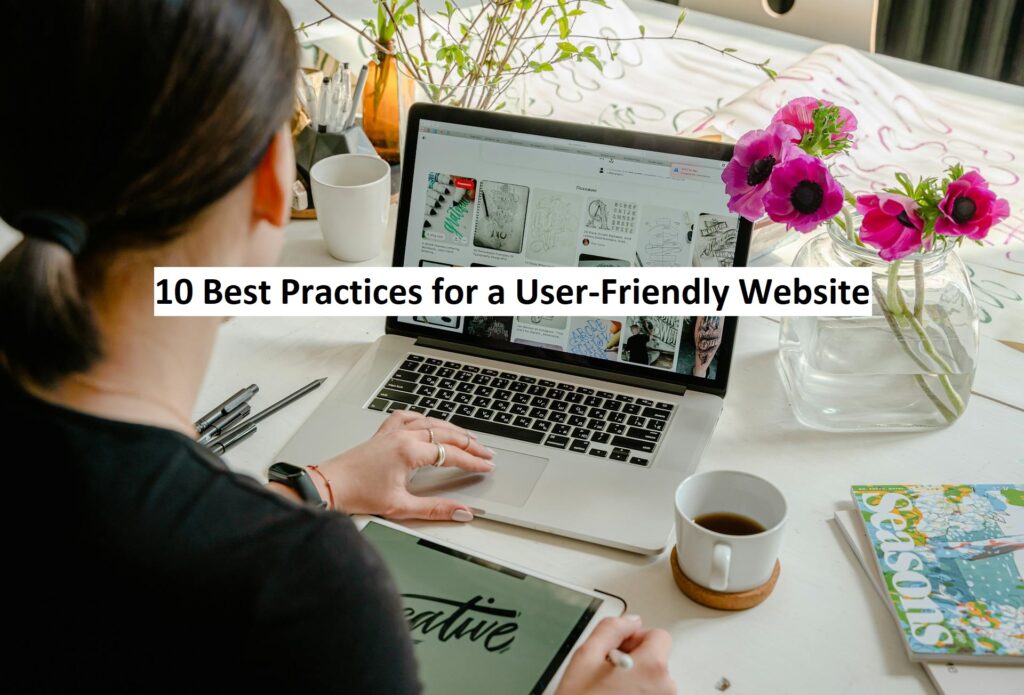Ever visited a website and left because it was too confusing or slow? A user-friendly website can greatly enhance user experience, affecting their satisfaction and likelihood of returning. So, what makes a website user-friendly, and why is it so important? Well, let’s break it down into ten best practices.
1. Keep It Simple and Organized
The best websites are easy to navigate. This means having a clean design where everything seems to have its place. When someone visits your website, they shouldn’t have to click around a lot to find what they’re looking for. For example, the home page should point to other sections like “About Us,” “Services,” and “Contact Us.” Each page should have a clear purpose and not be cluttered with too much information. A simple layout helps users find their way around the site without getting lost or frustrated.
Useful Tip:
Create a menu that’s easy to find and use. Ensure it’s clear and straightforward across the top of the page or in a dropdown format.
2. Make Your Website Mobile-Friendly
In today’s world, everyone uses their phones for just about everything, from watching videos to shopping. That means your website must look good and work well on mobile devices. If it doesn’t, visitors might leave and not come back. A mobile-friendly design adjusts to different screen sizes and orientations without losing functionality. This means big, easy-to-click buttons, text that’s easy to read without zooming in, and images that load quickly and fit the screen.
Useful Tip:
Thoroughly test your website to ensure it looks and functions properly on various devices. Tools like Google’s Mobile-Friendly Test can help you evaluate your site’s performance on mobile devices.
3. Speed Up Your Site
No one likes to wait, especially online. If your website takes too long to load, people won’t wait around; they’ll go somewhere else. A fast-loading website keeps visitors satisfied and pleases search engines, increasing the probability of it appearing in search results. To speed up your site, you can compress images, use website caching, and reduce the number of plugins you use.
Useful Tip:
Use tools like Google PageSpeed Insights to check your website’s speed and get specific advice on making it faster.
4. Use High-Quality Images and Videos
Pictures and videos can tell a story much faster than text alone. High-quality images and videos can capture your visitors’ attention and keep them engaged. However, ensuring they’re optimized for the web is important so they don’t slow down your site. This means using the right file formats and compressing them without losing quality.
Useful Tip:
When using images and videos, always check that you have the right to use them on your website. There are many sites where you can find free or paid media you can legally use.
5. Be Accessible to Everyone

Your website should be easy for everyone, including people with disabilities. This is not only good practice—it’s also a legal requirement in many places. Making your website accessible can involve adding text descriptions to images (so screen readers can describe them to visually impaired people), ensuring your site can be navigated with a keyboard (for those who can’t use a mouse), and using colors that are easy to see.
Useful Tip:
Utilize tools such as the WAVE Web Accessibility Evaluation Tool to assess your site’s accessibility and identify areas for improvement.
6. Use Descriptive and SEO-Friendly URLs
Using clear and descriptive URLs can improve the user experience and boost your SEO. A good URL should be easy to read and understand. It should give an idea of what the page is about without looking at the content.
Useful Tip:
Keep your URLs short, use dashes to separate words, and avoid numbers and special characters. This makes them easier to read and better for SEO.
Read: Understanding the Essentials of Outsource SEO Company
7. Offer Excellent Customer Support
Having a section for customer support that is easy to access and use can significantly enhance the user experience on your website. Whether it’s a detailed FAQ section, a live chat feature, or a simple contact form, users should feel they can easily reach out for help when needed. Quick and helpful customer support can turn a frustrated visitor into a satisfied customer.
Useful Tip:
Consider adding a chatbot to your site that can answer common questions instantly. For more complex issues, ensure users can reach a human who can help them.
8. Regularly Update Content
Regularly updating your website’s content is crucial. Outdated information can make your site appear neglected, damaging your brand’s reputation. Regular updates keep visitors returning and can help your site’s SEO. Updating content regularly signals to search engines that your site is active, potentially improving your search rankings.
Useful Tip:
Set up a schedule to review and update your content regularly. This could be once a month, once a quarter, or whatever suits your ability to produce new content. Don’t forget to update your images and videos as well.
9. Consistent Style and Branding
Consistency is key in web design. Your website should have the same colors, fonts, and layout styles across all pages. This reinforces your brand identity and gives your site a professional appearance. Consistency also helps users feel more comfortable navigating your site because they know what to expect on each page. For example, if your buttons are blue and rounded on the home page, keep them the same on all other pages.
Useful Tip:
Create a style guide that details all the design elements of your website. This can include typography, color schemes, button styles, and even the tone of your written content. If you think this is a difficult task, look for professionals in your area. For example, if you live in Florida, searching for experts in web design, FL will make sure your website includes all your branding elements, ticking all the right boxes.
10. Clear Calls to Action
A call to action (CTA) is a prompt on a website that encourages users to take a particular action, such as “Sign Up,” “Learn More,” or “Buy Now.” Clear CTAs are crucial for a business’s website because they guide the user toward taking a step that might lead to a sale or another important outcome. Make sure your CTAs are visible. Use contrasting colors to make them stand out, and place them in logical spots where users might be ready to decide.
Useful Tip:
Experiment with different versions of your CTAs to determine which ones generate more clicks. Utilize A/B testing tools to compare different texts, colors, and placements to identify what resonates most effectively with your audience.
Conclusion
Building a user-friendly website involves understanding what your users need and how they navigate your site. By following these ten best practices, you can develop a website that draws in visitors and converts them into loyal customers. Remember, a successful website should be visually appealing, functional, and user-friendly. Remember these tips, and you’re on your way to creating an exceptional online presence.



